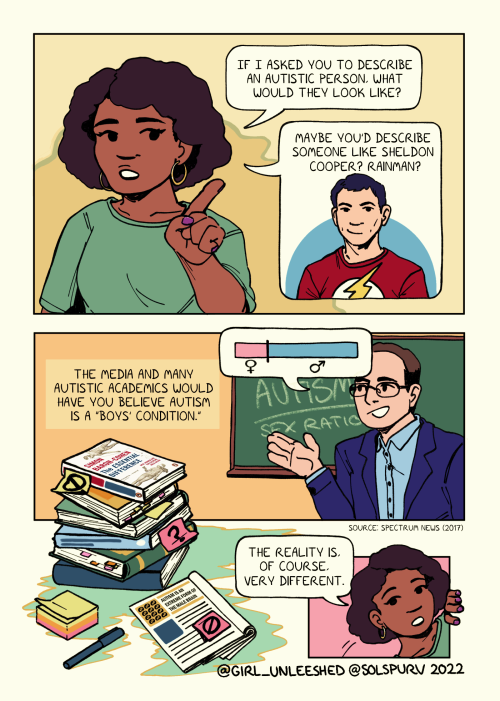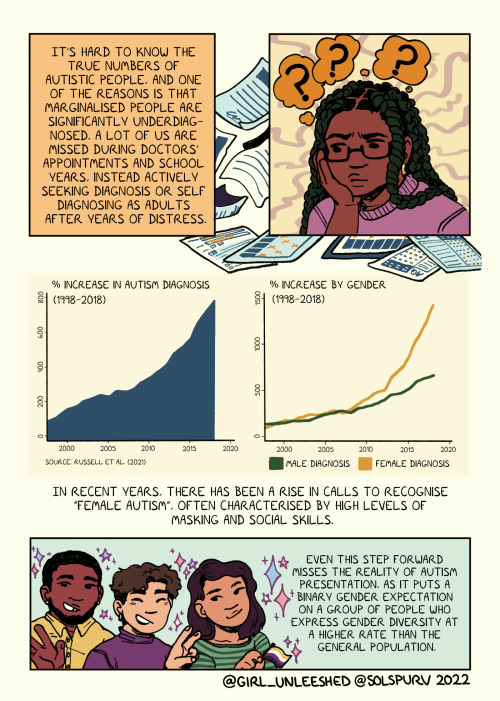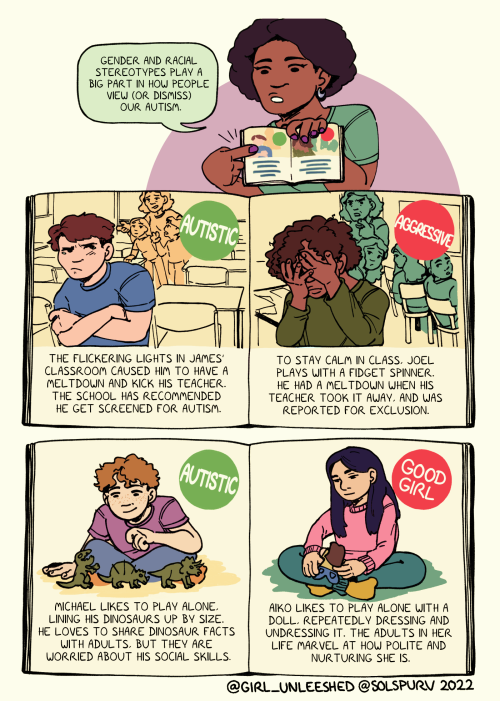solspurv:solspurv:“The focus on cis white male presentations of autism creates a massive diagn
solspurv:solspurv:“The focus on cis white male presentations of autism creates a massive diagnosis barrier for marginalised people. Our actions are viewed differently depending on our race / gender etc. We need better representation in media and we need academics to understand and embed cultural nuance, not seek to further restrict diagnosis.” (@girl_unleeshed on Twitter)Here’s the second comic I worked on for Autism Acceptance month! This comic is a collaboration with Leesha (@girl_unleeshed). Please check out her Twitter to read more of her awesome and thoughtful writing! [ID: A four page comic about how stereotypes affect autism diagnosis. The comic has a muted colour palette of primarily oranges, pinks and greens. Page 1: Our narrator (Leesha) appears at the top of the page and asks “If I asked you to describe an autistic person, what would they look like? Maybe you’d describe someone like Sheldon Cooper? Rainman?” Next to the question is a picture of Sheldon from the big bang theory.The next panel shows a man (who may or may not be Simon Baron-Cohen) infront of a blackboard. His speech bubble is a graph with a ratio of 1:3 girls to boys. Text says “The media and many autistic academics would have you believe autism is a ‘boys condition’” Below is a pile of books and articles with post it notes that show question marks and strikethroughs. One of the books is “The essential difference” by Simon Baron-Cohen. To the right, Leesha pops out of the corner saying “The reality is, of course, very different.” Page 2: Block of text: “It’s hard to know the true numbers of autistic people and one of the reasons is because marginalised people are significantly underdiagnosed. A lot of us are missed during doctors appointments and school years, instead actively seeking diagnosis / self diagnosing as adults after years of distress” Next to this is a Black woman in box braids, looking confused, with question marks above her head. Below are two graphs showing autism diagnosis from 2008-2018. The first shows a general upward trend, the second shows exponential growth of “female” diagnosis. Text reads: “In recent years, there has been a rise in calls to recognise “female autism”, often characterised by high levels of masking and social skills” Three smiling faces, one waves an enby flag. Text reads “Even this step forward misses the reality of autism presentation, as it puts a binary gender expectation on a group of people who express gender diversity at a higher rate than the general population" Page 3: Leesha holds a book says “Gender and racial stereotypes play a big part in how people view (or dismiss) our autism.” The book shows James (white) and Joel (Black). James is in his classroom angry with a scared teacher behind him. “The flickering lights in James’ class give him a meltdown and he kicks his teacher. The school recommends an autism screening.” Green stamp: autisticJoel is in his classroom and looks distressed, his teacher looks angry. “To keep calm, Joel uses a fidget spinner. He has a meltdown when it’s taken away and he is reported for exclusion.” Red stamp: aggressive The next page shows Michael and Aiko. Michael lines up toy dinosaurs. “Michael likes to play alone, lining dinosaurs up by size.He loves to share facts with adults but they worry about his social skills. Green stamp: autistic Aiko plays with a doll. “Aiko likes to play alone with a doll, repeatedly dressing /undressing it. Adults marvel at how polite and nurturing she is. Red stamp: good girl Page 4: Book shows Luke and Zeinab Luke sits with a psychiatrist. “Luke has always excelled in school, but he is overwhelmed with university and stops attending. After a referral to a psychiatrist, he is diagnosed with autism. Green stamp: autistic Zeinab sits with a psychiatrist. “Zeinab is is pursuing a private diagnosis. She is misdiagnosed with BPD and anxiety because she makes eye contact and tells a joke” Red stamp: not autistic Leesha returns, holding a book and saying: “Rather than help us seek timely diagnosis and invest in meaningful support services, there have been claims of overdiagnosis and moves to restrict the already narrow diagnostic criteria on the new DSM 5” Zeinab, Joel and Aiko hug and smile, text reads “There are autistic people in every demographic. Late / self diagnosis doesn’t make us less autistic or mean we are faking it. In fact, it’s often a symptom of the harmful stereotypes that permeate society from our medical fields to our media and beyond.” End ID.] -- source link
Tumblr Blog : solspurv.tumblr.com
#short comic



